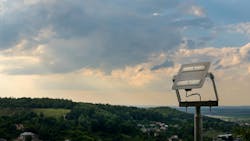EPA Explained: The Influence on Utility and Light Pole Purchase Decisions
EPA, or Effective Projected Area, measures the size of the cross-sectional area of a fixture and its components as seen by the wind. This determines the overall strength of a fixture and the amount of wind load it can resist.
EPA represents the visible portion of a three-dimensional object on a two-dimensional plane at a specific angle. For example, a cone can appear as a triangle or a circle, depending on the viewing angle.
What is EPA Wind Rating?
EPA wind rating indicates the maximum wind speed a pole-mounted fixture can withstand in a given area. Durable fixtures with more weight apply additional force to the pole and mounting hardware, influencing its wind rating and structural longevity.
Each component of a light pole assembly, including the poles, fixtures, and tenons, has its own EPA rating. The overall EPA and combined weight of each component must stay within the pole’s maximum wind zone rating for the specific location. These considerations extend to utility, telecom, and security pole applications.
Wind zones vary by region, with most U.S. areas facing worst-case scenarios of 70-90 MPH. Coastal environments and hurricane-prone areas, such as Miami and Houston, experience wind speeds up to or in excess of 110 MPH, requiring poles to be engineered to meet these extreme conditions without failure. EPA wind rating is calculated to establish the proper configuration of pole-mounted components for the installation area.
In short, each of the factors of EPA identifies the structural capacity of wind-induced forces a fixture can support by geographic region.
Utility Equipment and Light Fixture Drag Profile
Each component has a drag profile that describes how much wind pressure it can withstand. The Drag Coefficient (Cd) determines how much wind drags against a fixture and varies based on the engineered shape. For example; square poles with sharp corners create more drag than round poles, influencing a higher drag factor on the pole.
EPA Ratings by Region
EPA measurements are especially important in worst-case weather areas. Examples include:
Based on government-defined EPA measures in these types of environments, light or utility poles are a must to withstand intense environmental conditions.
The following components are needed to conform to EPA structural requirements in these environments:
- Resilient utility and light poles with superior EPA wind ratings
- Sturdy, durable wet location pole components
- Rugged pole tenons for installation
How to Calculate Wind Ratings
Wind ratings are determined by combining worst-case wind pressure, light fixture weight, and the fixture’s EPA. The EPA is calculated by multiplying the Projected Area (A) by the Drag Coefficient (Cd), which measures resistance in the air (EPA = A x Cd).
The drag coefficient varies with the object's shape. Lower drag coefficients indicate less wind resistance by an object. The Projected Area (A) is measured in square feet and represents the area of the pole or pole components exposed to high wind velocities.
Light and utility pole selection depends on the installation wind zone and the components of the light or utility pole such as pole height, mounting bracket type, and wires. Since light fixtures have a unique EPA, it’s essential to calculate or verify manufacturer specifications to ensure safe installation on utility poles.
Potential Light Fixture Infrastructure Issues in High-Wind Environments
Selecting the proper outdoor light fixture solution is critical in worst-case weather environments where EPA rating is a concern. If improper pole components are installed, potential public safety risks and avoidable structural damage can occur leading to potential hazards with failing fixtures.
Improper light fixture installation with a pole-mounted fixture that isn’t rated to withstand high-wind weather conditions can lead to the pole breaking off or the pole falling over completely requiring replacement in a worst-case scenario. In these disastrous conditions where regions may already be experiencing infrastructure hardship, unexpected repair costs can be eliminated with the proper pre-planning before installation.
Selecting the proper light or utility pole solution that adheres to EPA regulations is critical for pole projects, especially in more extreme weather environments. Proper planning ensures pole longevity and structural integrity, the ability to withstand harsh weather conditions, appropriate lighting levels, and optimal public safety. A knowledgeable Pole Specialist will consider EPA regulations when providing a product solution to ensure optimal safety and longevity.
About the Author
Chelsea Jones
Chelsea Jones is the Digital Marketing Manager at LED Lighting Supply with 7+ years of experience putting herself in the customers' shoes to understand their pain points and assist them in making informed buying decisions. She enjoys writing, educating, and building the necessary resources to help customers make those decisions.

